
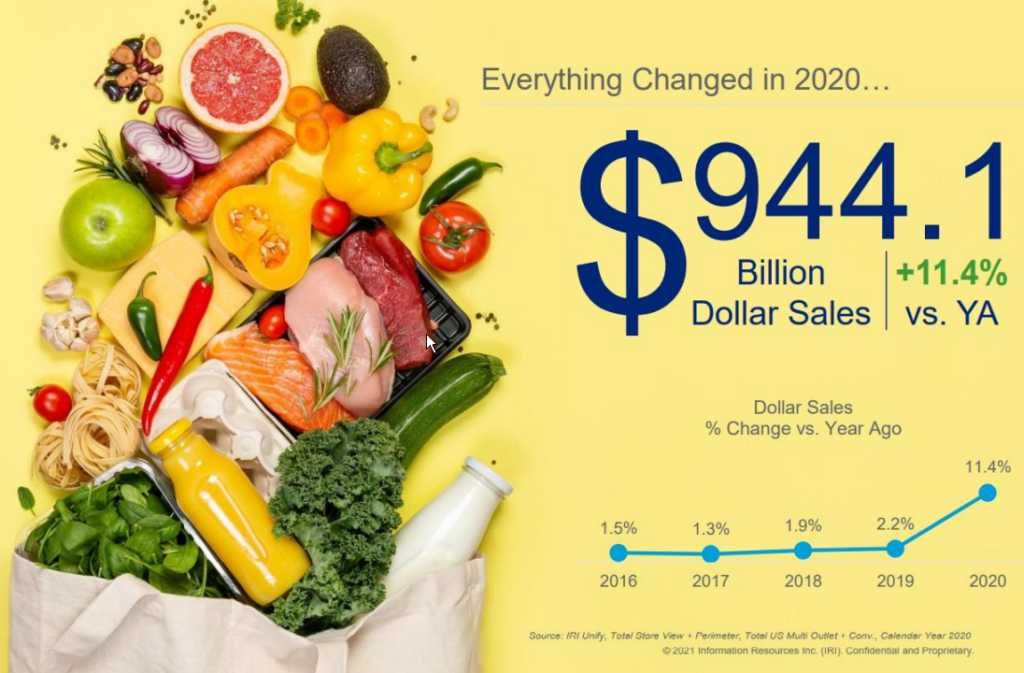
Few departments are able to keep pace with their record 2020 sales and meat is no exception. During the first seven months of 2021, sales fell 4.5 percent when compared to the same time period in 2020. Fresh meat sales accounted for slightly more of that loss, at -5.2 percent. However, meat department sales are trending well ahead of the first seven months of 2019, at 17.1 percent, driven by the average number of at-home meals still higher than pre-pandemic where food service was more evenly mixed in the household routine.
“Shoppers are more accustomed to cooking now, so even as restaurants and mobility renews, eating at home is still seen as a cost savings”
–JONNA PARKER, TEAM LEAD FOR IRI FRESH

Week-by-Week July Sales

Independence Day week was the biggest of the four July weeks, at $1.8 billion in sales in the U.S. Despite more Americans celebrating with gatherings for the holiday, this was down about 5 percent from last year.
The subsequent July weeks average $1.5 to $1.6 billion in sales and came closer to the every day July sales levels seen in 2020, according to IRI data. All July weeks came in double digits ahead of the 2019 sales results.
However, the drop of home-prepared meals and the return to on-premise restaurant dining did result in the lowest volume gains versus the 2019 normal, at 1.3 percent. This is down nearly one percentage point from June.
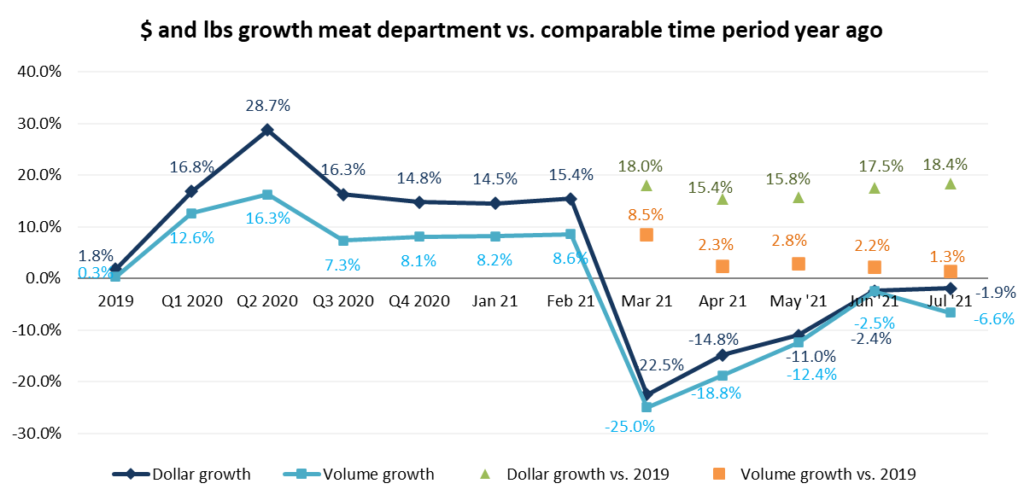
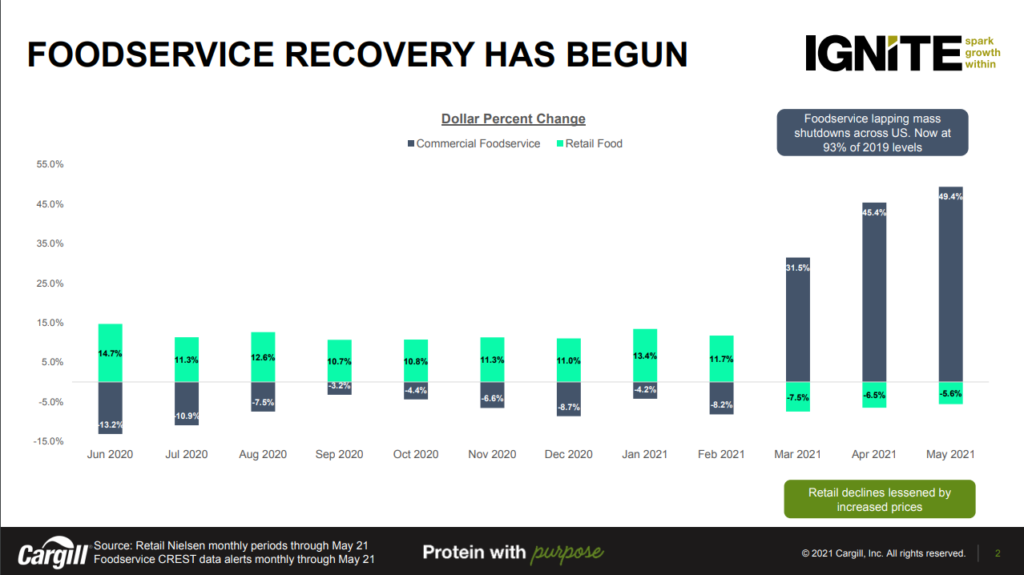
Processed Meat — Growth in Three Areas, Including Powerhouse Bacon
Processed meat grew over and above the 2020 and 2019 sales levels, driven by robust bacon, packaged lunchmeat and processed chicken sales. Bacon and packaged lunchmeat are the two biggest sellers within processed meat and their gains easily offset the declines seen in dinner sausage, hot dogs and breakfast sausage.

Where we are headed…
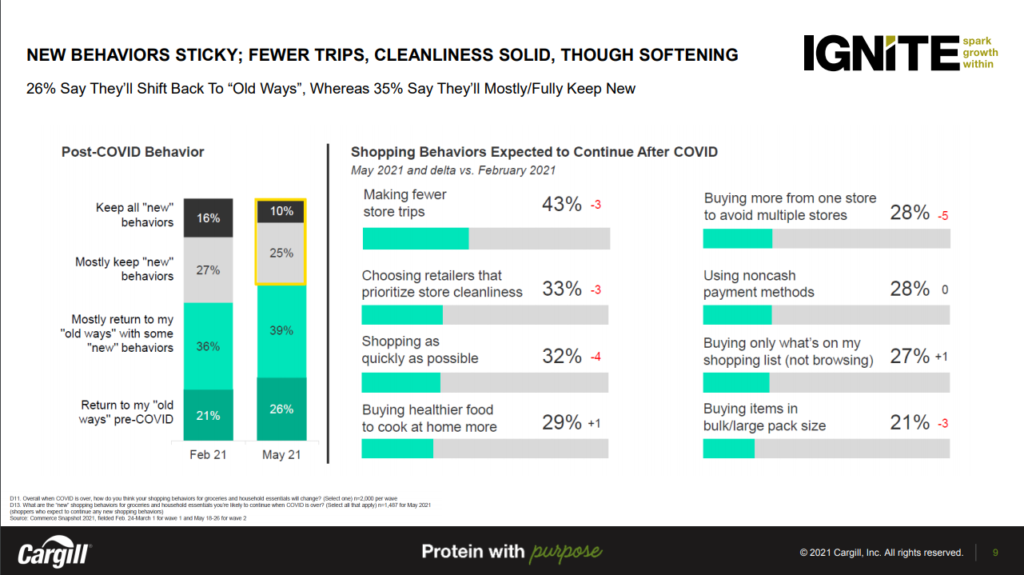
Beef
Demand for U.S. beef remains strong in both domestic and international markets.
- Beef buyers remain focused on full supply chains. Even at higher retail prices, consumer pushback has been limited thus far. This feedback clearly supports a procurement model in which keeping shelves full takes precedence over the potential of lower wholesale prices in the future.
- Inflation is driving prices higher, but is being offset (somewhat) by guaranteed income in consumer’s pockets. It should take several months after disposable income recedes before consumers are forced to respond via reallocating or limiting expenditures.
- Daily capacity for the beef industry has shown very little improvement over the past several months. Fed cattle supplies are still historically large, but not to be considered “overly burdensome.”

Imports have picked up for both muscles and trim as an attempt to offset some of the lighter domestic production. Year-to-date, the Japanese, South Korean, and Chinese markets are all exhibiting strong demand for U.S. beef. Exports during 2021 are expected to be 15 percent above 2020 levels.
While beef consumption has been below last year’s numbers, demand has been better than expected resulting in higher retail prices. This can be absorbed by the consumer in the short run, but if gains in disposable income or government support begin to wane, then beef prices could start to see some pushback. Exports during 2021 are expected to be 15 percent above 2020 levels.

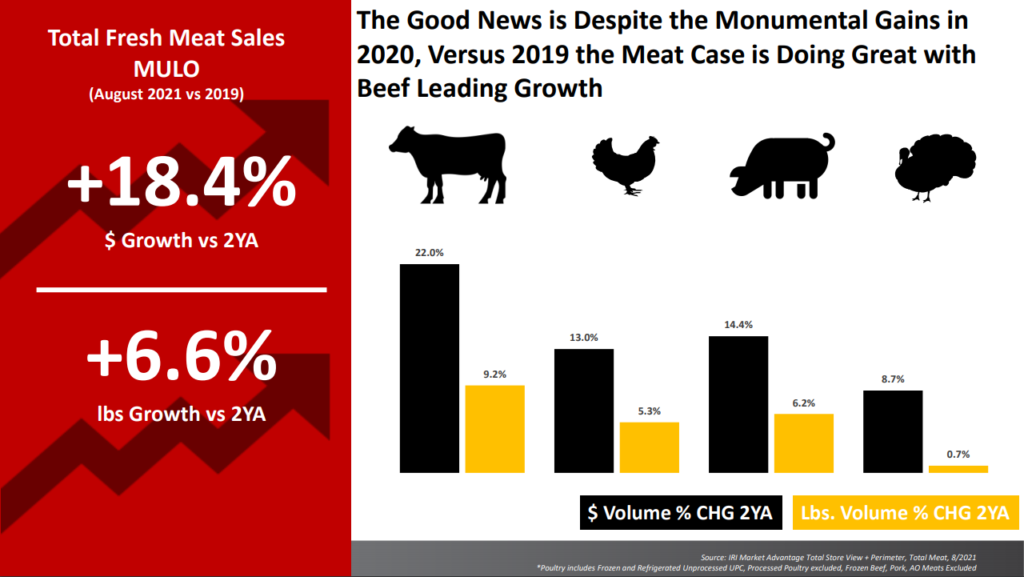
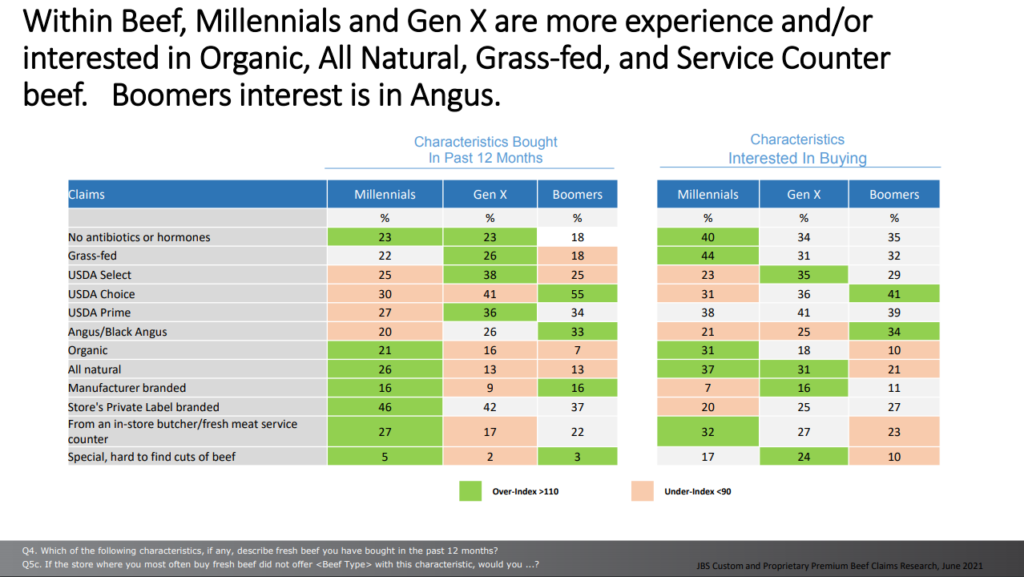
Pork
Fresh and frozen product availability is low as domestic and export demand are strong.
- Slaughter rates continue to fall below a year ago as hog availability is limited.
- Average live-weights have converged with pre-pandemic levels, declining 12 lbs./head from January to July.
- Domestic and export demand for U.S. pork continues to be strong, keeping product out of cold storage stocks.
- Exports to China remain lackluster as China has signaled they are no longer interested in buying substantial volumes of U.S. pork.
- Peak demand season will be behind us after Labor Day, so prices are expected to ease off.

Boneless hams are extremely difficult to come by at the moment. Post-July 4, there has been a noticeable reduction in labor, causing more shortages. Packers are in full allocation mode and it’s a struggle to keep up with regular rake order demand. Expect this to be a problem through the end of the year. Hams will be a week-to-week struggle from manufacturers.

Cold storage stocks fell 4 percent in June, putting volume well below last June when stocks were extremely depleted from the pandemic. Stocks are now down 4 percent year over year after being down 26 percent year over year in June 2020 and are not expected to rebuild this year as slaughter rate is expected to stay below last year’s year level and demand is expected to stay robust.
Chicken
The broiler market was steady in August, in terms of production and price.
- Chick placements have been below expectations as a result of low hatchability levels so far this year.
- Cold storage stocks are still well below year ago, despite a slight increase in storage volume the past month.
- Exports to Mexico are strong and expected to grow further in the second half of the year.
- Slaughter rate has been above year ago for the past few months despite labor shortages at plants.
- Chicken is headed into a lower-demand time of year heading into the fall, evident in breast meat prices easing off yearly highs.

Cold storage stocks are still well below a year ago but regained some ground in June. Stocks were up 1 percent from May to June but were still down almost 15 percent versus prior year as of June.

Domestic consumption for all meat products has been strong this summer, including for chicken. Consumption is expected to stay above year ago for the summer months.

Turkey
Hen and tom production are showing different trends this year, resulting in very different price movement for commodity parts and whole birds.
- Tom slaughter is still down year over year, limiting fresh and frozen product availability and resulting in price increases for tom parts. Hen slaughter is only down slightly from avyear ago despite tom slaughter struggling.
- Total cold storage stocks are down an average of 15 percent year over year.
- Exports to Mexico are strong as they are for pork and chicken as well. Exports to destinations aside from Mexico are small.
- Turkey prices are already highly priced relative to the current supply so any decreases in demand could lead to prices easing off.

Domestic demand for meat has been strong this summer as food service consumption has been up. As a result, total consumption is surging for turkey.

Total turkey stocks are down almost 15 percent year over year, primarily driven by a decrease in breast meat volume compared to a year ago. Whole bird stocks are down 11 percent year over year. Breast stocks are down almost 30 percent.

Seafood
Seafood Across the Store for the First Seven Months of 2021
Frozen seafood leads year-to-date sales through July 25, with 30-week sales of $4.3 billion. This was up 1.7 percent in dollars, but down slightly in units and volume. Fresh seafood sales for the first half of 2021 were a very close second, with gains in dollars, units and volume when compared to the first 30 weeks of 2020.

Month-by-month, all three areas continue to sit slightly below 2020 levels but are tracking far ahead of the July 2019 results.

Sales for finfish were slightly higher than shellfish, at $298 million versus $244 million. Finfish also had the better dollar and volume performance when comparing sales to a year ago. However, this picture is somewhat skewed due to the enormous strength of shellfish throughout 2020. When compared to 2019, it is shellfish that leads all growth at 36.2 percent versus the pre-pandemic normal and 21.0 percent for finfish. This is a clear illustration that fresh seafood continues to enjoy very strong demand over typical levels, even if the year-over-year view is negative.

Retailers continue to invest in a broader fresh seafood assortment, especially in finfish. The average number of fresh seafood items per week per store increased by 1.1 percent in July 2021 versus the same month in 2020.

Salmon Accounts for a Third of All Fresh Seafood Sales and Yet Continues to Grow
Salmon is, by far, the biggest seller within fresh seafood, with July sales of $568 million. This reflects a 28.3 percent increase versus the pre-pandemic normal of 2019, and an 0.7 percent increase versus 2020. Four other areas managed a year-over-year increase, which were shrimp, tilapia, cod and seafood/crab cakes.

Frozen Seafood Sales
Frozen seafood has been a growth leader across frozen food offerings month after month. Both in 2020 and the first half of 2021, sales have grown because of more people buying frozen seafood, people buying it more often and spending a little more per trip. In July 2021, frozen seafood sales totaled $557 million, the highest of all frozen protein offerings. This constitutes a 44 percent increase over the 2019 normal.
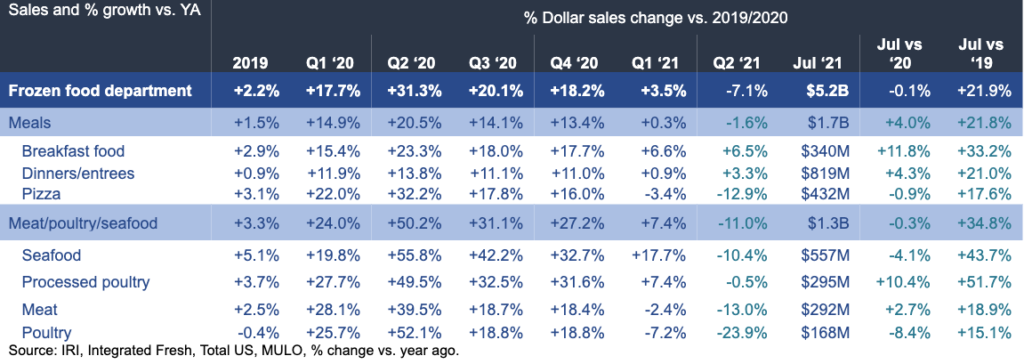
By cut, frozen fish was the largest category in July, at $243 million. The second-largest segment, frozen raw shrimp, was up the most in comparison to pre-pandemic levels, at an unbelievable 61.9 percent.








